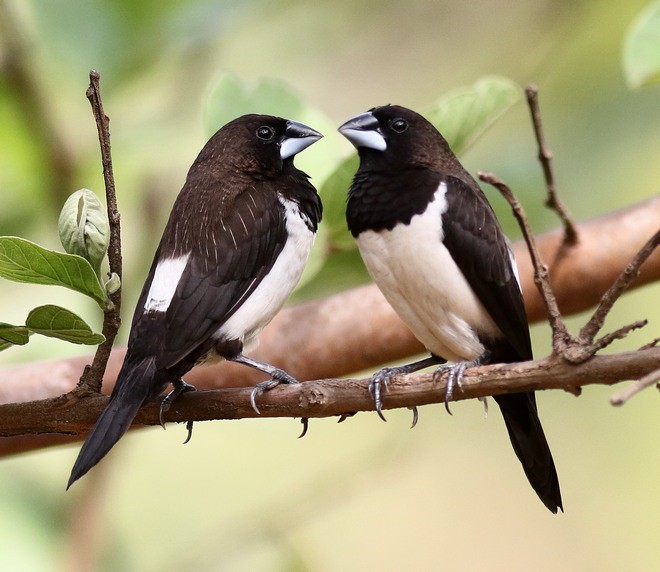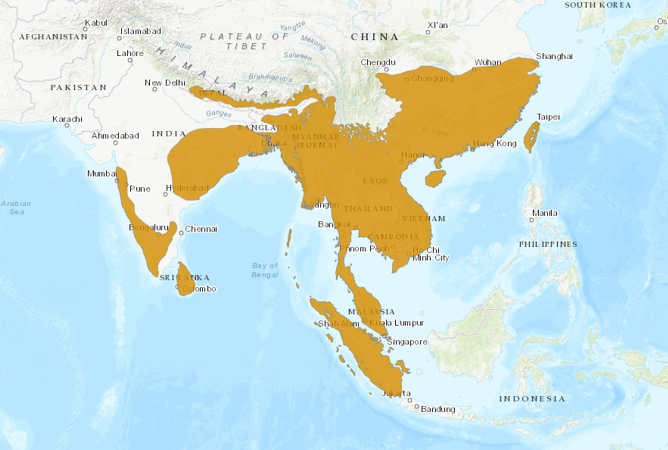Birdfinding.info ⇒ Locally common in several parts of its large range, including southwestern India, Sri Lanka, northern and central Thailand, Penang (Malaysia), Hong Kong, and Taiwan. Apparently reaches peak abundance in the western and eastern ends of its range, especially in India’s coastal lowlands from Goa to Kerala, and the lowlands of Taiwan. Near Bangkok, it is readily found in the ricefields at Lat Krabang. In Hong Kong, Long Valley is a consistent site.
White-rumped Munia
Lonchura striata
Southern and eastern Asia south to western Indonesia, where it inhabits a wide variety of lush grassy, marshy, brushy, and lightly wooded habitats.
The nominate subspecies occurs mainly along the western coast and southern provinces of India and on Sri Lanka, then patchily across east-central India to Bangladesh. Two similar subspecies, subspecies, fumigata and semistriata, occupy the Andaman and Nicobar Islands.
Acuticauda occurs in the Himalayan foothills from north-central India (Uttarakand) east through Myanmar and into the Southeast Asian hill country of southern China, northern Thailand, and Laos. To the south, it is replaced by subsquamicollis, which occurs across southern Indochina, the Malay Peninsula, Sumatra, and some adjacent islands.
In East Asia, swinhoei occupies much of eastern China (north to Shaanxi, Henan, and Jiangsu), Taiwan, Hainan, the Ryukyu Islands (Miyakojima and Okinawa), and northern Vietnam.
Identification
A small, brown-and-white munia with a large, silvery or bluish bill.
Its overall pattern is simple: the upperparts and chest are brown, and the lower breast, belly, and lower back are white.
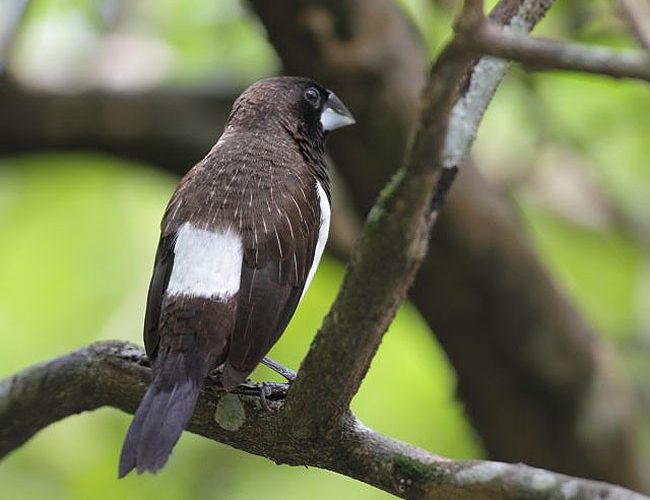
White-rumped Munia, L. s. striata, showing the white patch on its lower back—not rump—for which it is named. (Dehiovita, Sabaragamuwa Province, Sri Lanka; October 16, 2013.) © Mapalagama K. Premasiri
There is significant geographical variation in the details of coloration, with a distinct west-to-east progression from stronger to weaker contrast between upperparts and belly.
The southwestern subspecies, striata, and the Andaman and Nicobar subspecies, fumigata and semistriata, show strong contrast between the white underparts and the brown patches—usually darkest on the face, throat, chest, wings, and tail; elsewhere paler brown with whitish streaks.
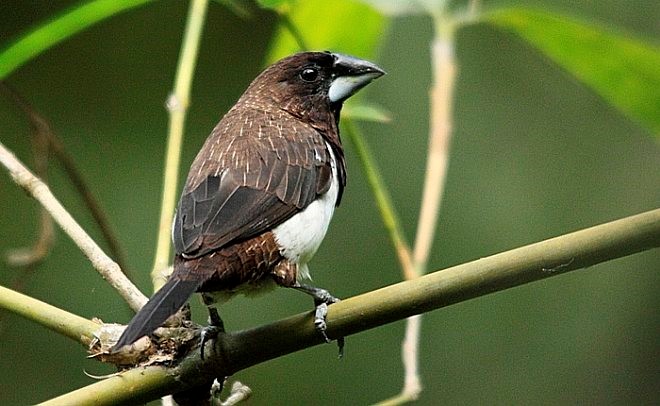
White-rumped Munia, L. s. striata, a typical view of a bird at rest, with the white “rump” patch concealed. (Shyamkhola, South 24 Parganas District, West Bengal, India; January 15, 2017.) © Prosenjit Singha Deo

White-rumped Munia, L. s. striata, showing crisp demarcation between brown and white. (Madgaon, Goa, India; January 24, 2016.) © Shyam Ghate
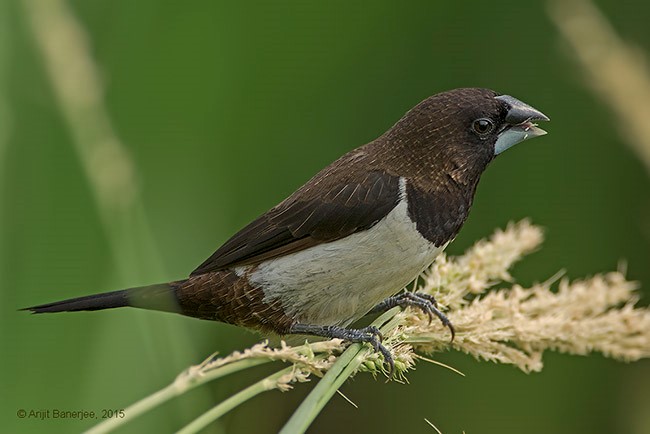
White-rumped Munia, L. s. striata, showing some pale streaks in the brown upperparts and dark streaks in the white underparts—thus intermediate between typical striata and acuticauda. (Patuli, Kolkata, West Bengal, India; June 13, 2015.) © Arijit Banerjee
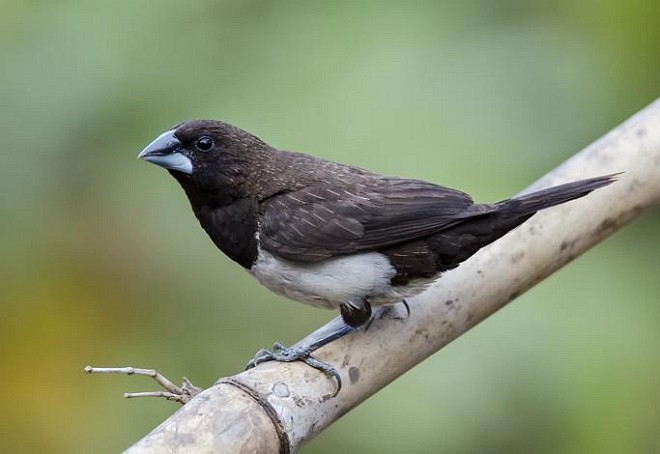
White-rumped Munia, L. s. striata, a typical view of a bird at rest, with the white “rump” patch concealed. (Gotheghar, Alibag Taluka, Raigad District, Maharashtra, India; February 7, 2016.) © Tushar Bhagwat
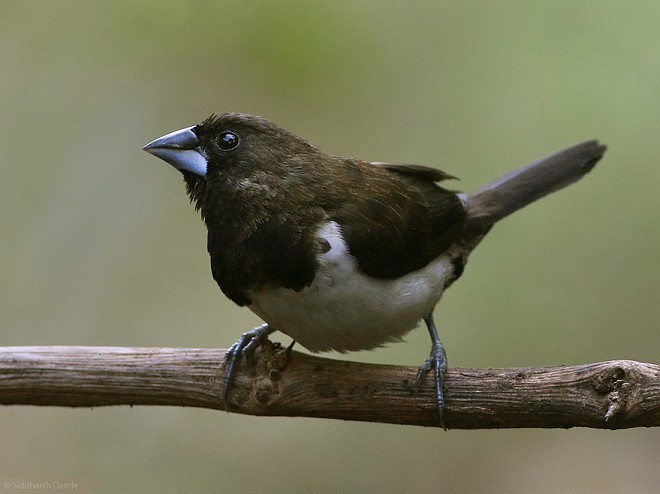
White-rumped Munia, L. s. striata—this subspecies often has unmarked, dark-brown upperparts. (Sinhagad, Pune District, Maharashtra, India; December 18, 2015.) © Siddharth Damle
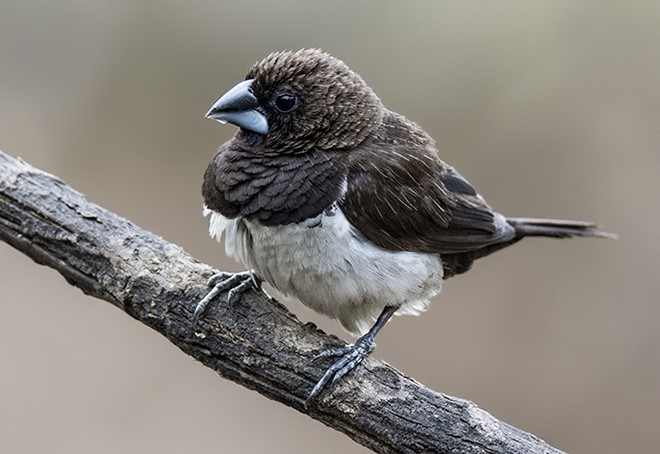
White-rumped Munia, L. s. striata, showing “frosted” brown upperparts in this lighting. (Gotheghar, Alibag Taluka, Raigad District, Maharashtra, India; March 11, 2018.) © Tushar Bhagwat
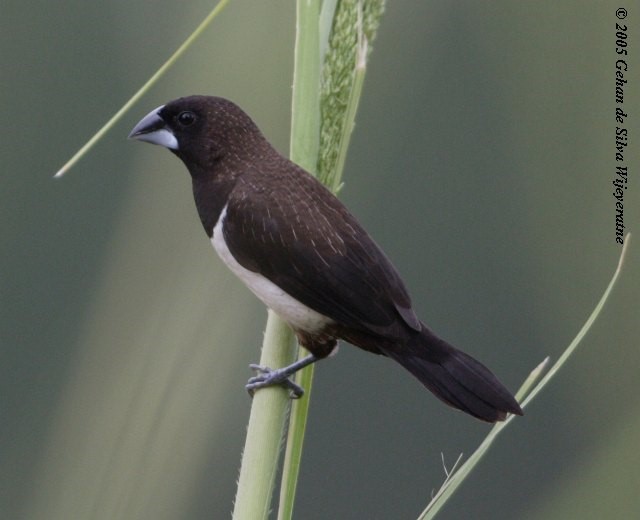
White-rumped Munia, L. s. striata, showing nearly uniform, dark-brown upperparts. (Hiriwadunna, Sri Lanka; September 14, 2005.) © Gehan de Silva Wijeyeratne
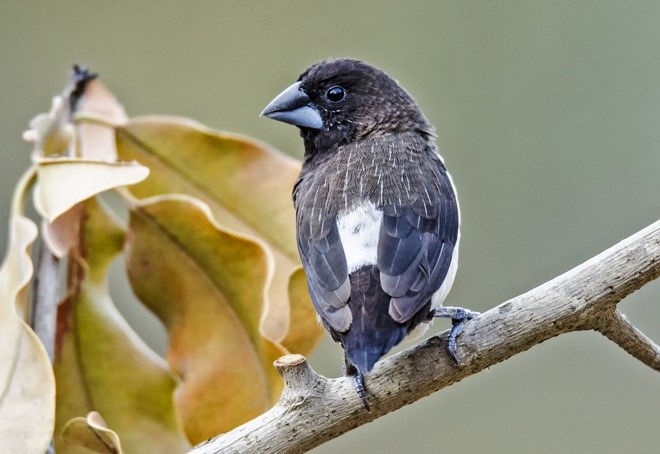
White-rumped Munia, L. s. striata, showing the white patch on its lower back—not rump—for which it is named. (Gotheghar, Alibag Taluka, Raigad District, Maharashtra, India; April 23, 2017.) © Tushar Bhagwat

White-rumped Munias, L. s. striata, showing the white patch on the lower back—not rump—for which it is named. (Gotheghar, Alibag Taluka, Raigad District, Maharashtra, India; June 4, 2017.) © Tushar Bhagwat

White-rumped Munias, L. s. striata, showing crisp demarcation between brown and white. (Goa, India; May 28, 2012.) © Hira Punjabi
The northwestern and southeastern subspecies, acuticauda and subsquamicollis, from northern India to northern Thailand and Vietnam, are similar to striata but show weaker contrast. The upperparts are a paler, bronzy brown and the white belly is marked with faint streaks.
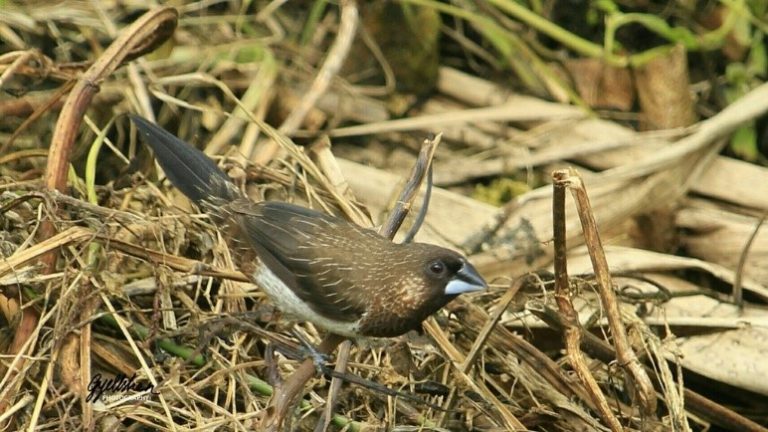
White-rumped Munia, L. s. acuticauda, showing the bronzy-brown upperparts typical of this subspecies. (Bhutan; October 21, 2017.) © Gyeltshen Gyeltshen
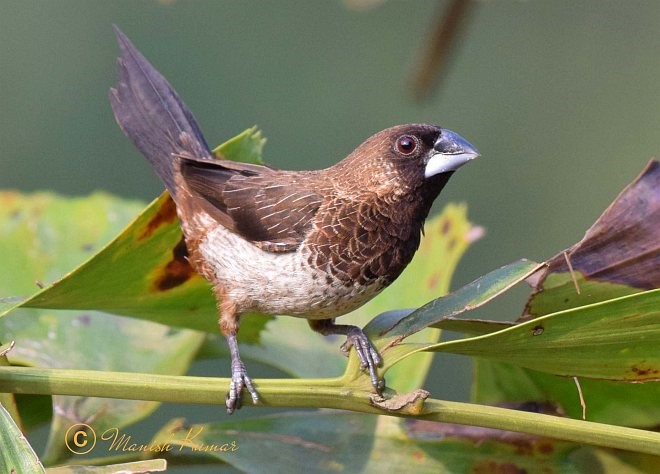
White-rumped Munia, L. s. acuticauda—note the uneven boundary between dark and light coloration on the breast. (Mahal, Melaghar, Sepahijala, Tripura, India; April 21, 2018.) © Manish Kumar
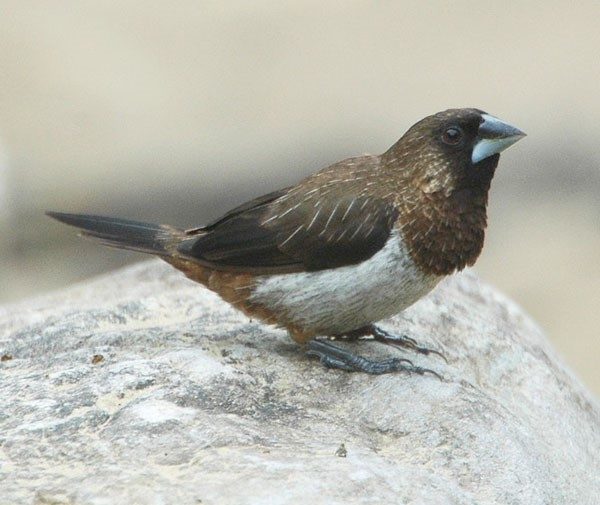
White-rumped Munia, L. s. acuticauda, showing the bronzy-brown upperparts and faintly streaked underparts typical of this subspecies. (Corbett Tiger Reserve, Uttarakhand, India; August 14, 2006.) © Nikhil Devasar
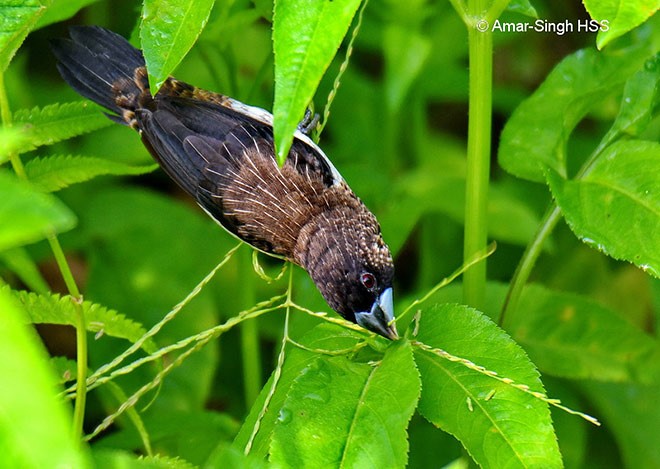
White-rumped Munia, L. s. subsquamicollis, dorsal view showing bronzy-brown coloration and streaks on upperparts. (Kledang-Sayong Forest Reserve, Ipoh, Perak, Malaysia; September 17, 2018.) © Amar-Singh HSS
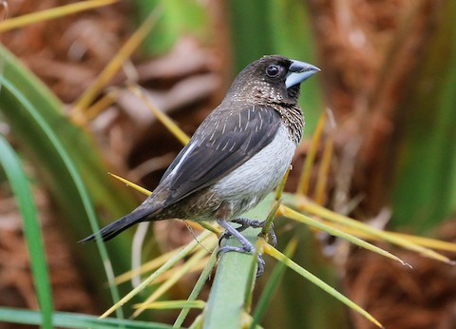
White-rumped Munia, L. s. subsquamicollis. (Relau Metropolitan Park, Penang, Pulau Pinang, Malaysia; January 21, 2018.) © Neoh Hor Kee
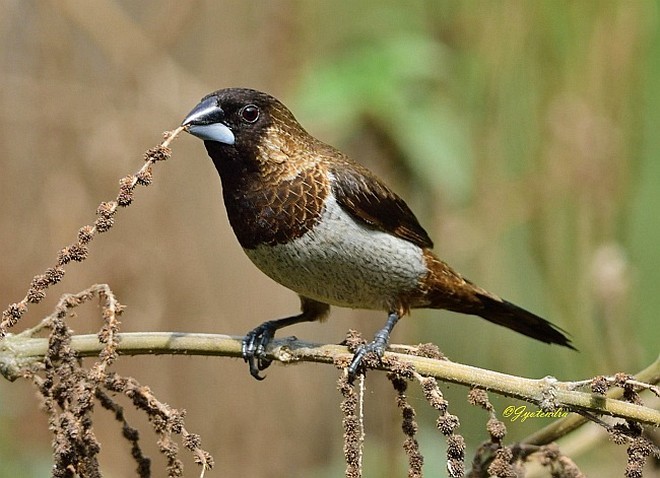
White-rumped Munia, L. s. acuticauda, showing the bronzy-brown upperparts and faintly streaked underparts typical of this subspecies. (Sundarijal, Kathmandu, Nepal; February 20, 2015.) © Jyotendra Jyu Thakuri
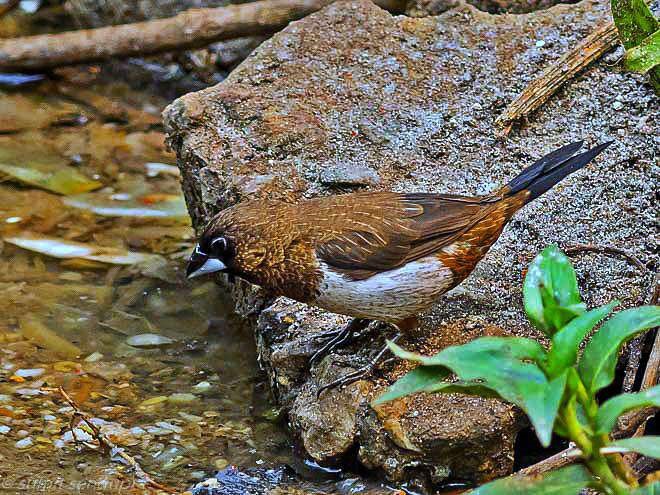
White-rumped Munia, L. s. acuticauda, showing the bronzy-brown upperparts and faintly streaked underparts typical of this subspecies. (Rudraprayag, Garhwal, Uttarakhand, India; April 30, 2016.) © Sumit Sengupta
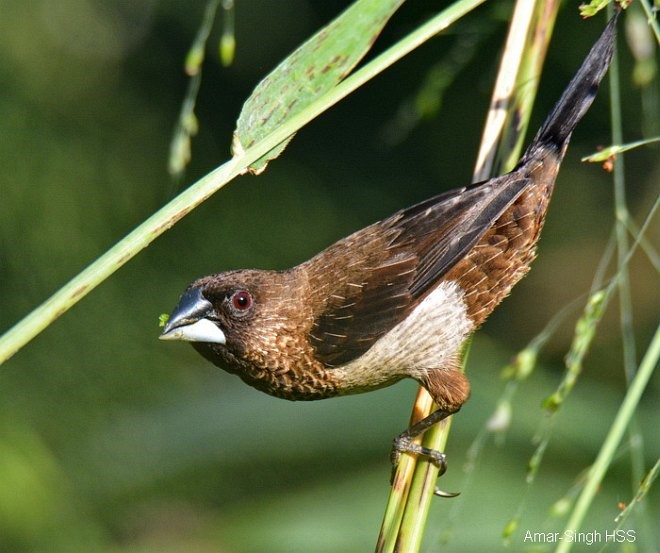
White-rumped Munia, L. s. subsquamicollis, showing the bronzy-brown upperparts and faintly streaked underparts typical of this subspecies. (Ipoh, Perak, Malaysia; December 7, 2015.) © Amar-Singh HSS
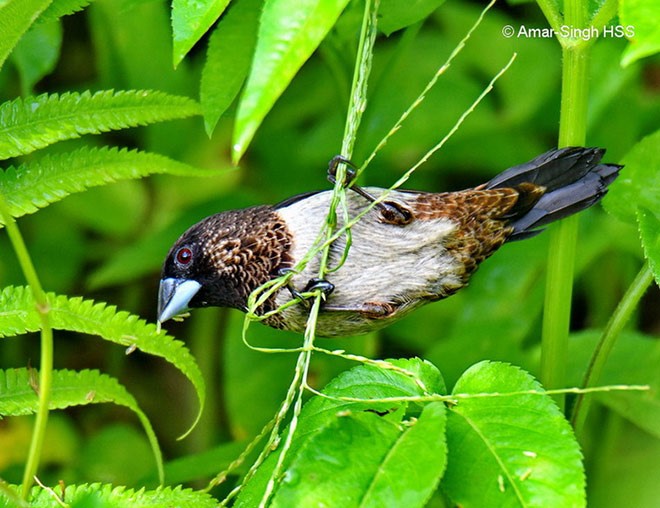
White-rumped Munia, L. s. subsquamicollis, ventral view showing bronzy-brown coloration and streaks on underparts. (Kledang-Sayong Forest Reserve, Ipoh, Perak, Malaysia; September 17, 2018.) © Amar-Singh HSS
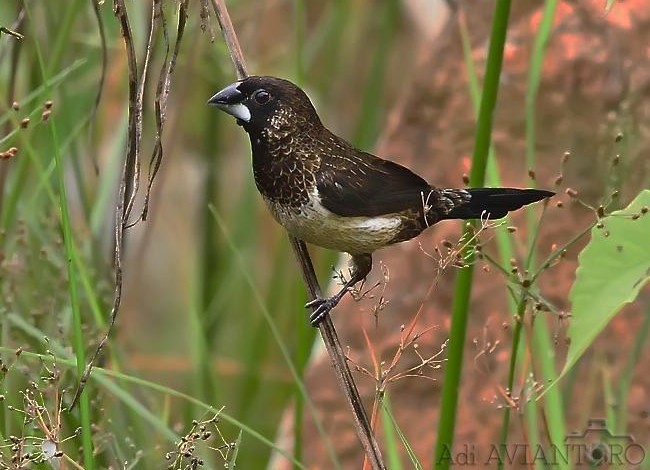
White-rumped Munia, L. s. subsquamicollis, showing somewhat darker-than-average upperparts and faintly streaked underparts. (Selangor, Malaysia; April 14, 2012.) © Adi Aviantoro
The northeastern subspecies, swinhoei, of East Asia, shows even less pronounced contrast. The upperparts are paler, especially on the chest and hindquarters, which are a bronze or cinnamon shade (which can appear more buffy than brown) and the white belly is marked with faint streaks.
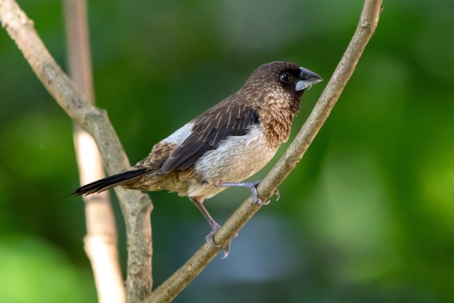
White-rumped Munia, L. s. swinhoei, showing the white patch on the lower back—not rump—for which it is named, and the pale, buffy-brown coloration typical of this subspecies. (Hong Kong; May 12, 2019.) © Oscar Ho
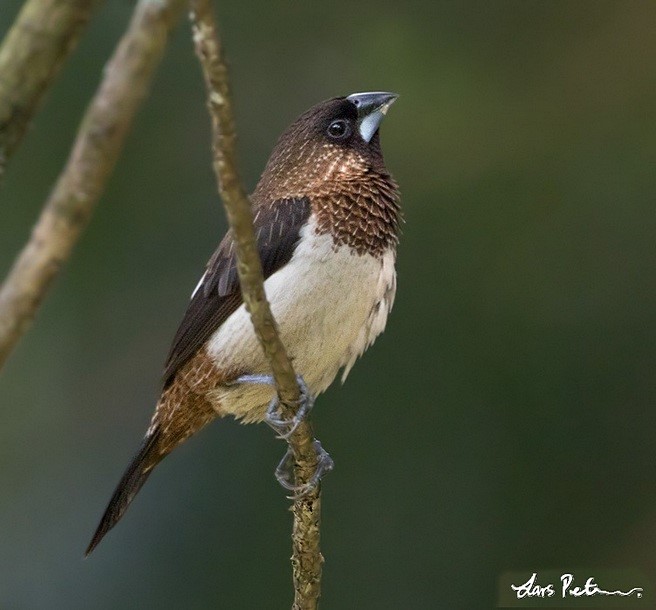
White-rumped Munia, L. s. swinhoei, showing bronzy-brown coloration and faintly streaked underparts. (Guguan, Taichung City, Taiwan; May 11, 2019.) © Lars Petersson
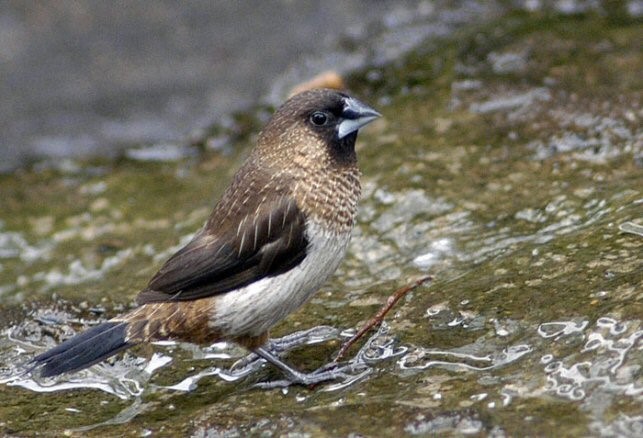
White-rumped Munia, L. s. swinhoei, showing the pale-brown coloration typical of this subspecies. (Hong Kong; March 2005.) © Neil Fifer
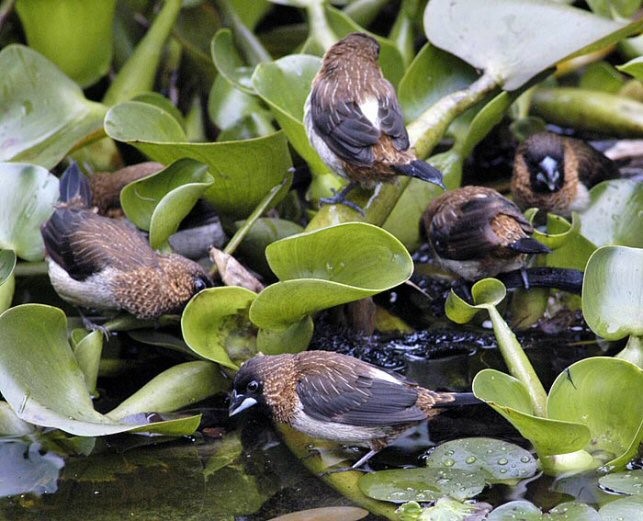
White-rumped Munia, L. s. swinhoei, showing the white patch on the lower back—not rump—for which it is named, and the pale-brown coloration typical of this subspecies. (Hong Kong; March 2005.) © Neil Fifer
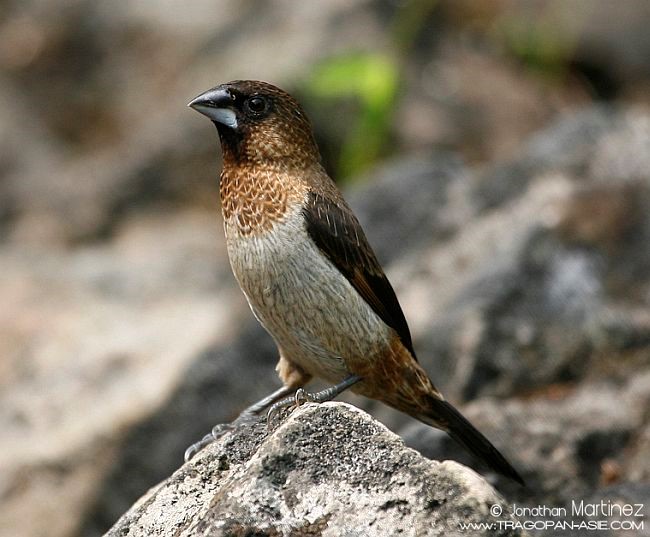
White-rumped Munia, L. s. swinhoei, showing bronzy-brown coloration and faintly streaked underparts. (Shanli, Guangxi, China; August 5, 2011.) © Jonathan Martinez
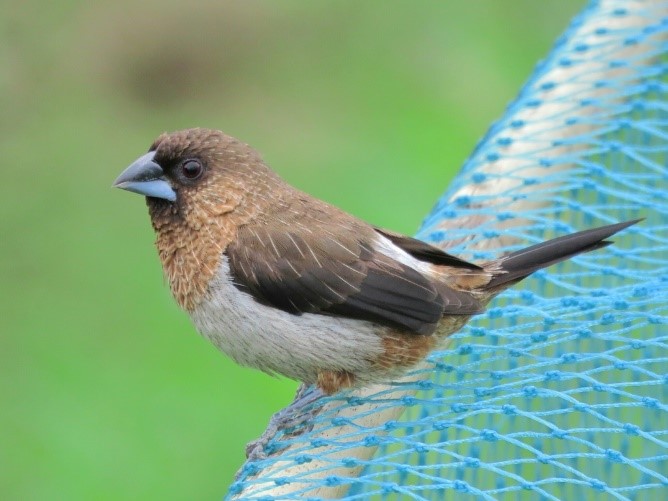
White-rumped Munia, L. s. swinhoei, showing the pale, buffy-brown coloration typical of this subspecies. (Hong Kong; October 20, 2017.) © kwongchungman
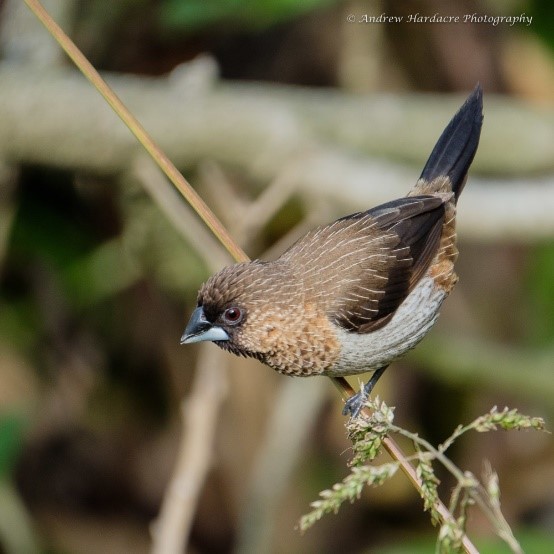
White-rumped Munia, L. s. swinhoei, showing the pale, buffy-brown coloration typical of this subspecies. (Hong Kong; February 23, 2018.) © Andrew Hardacre
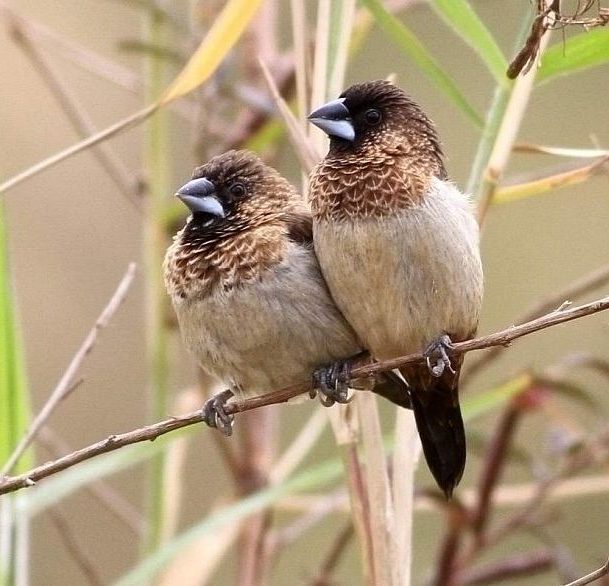
White-rumped Munias, L. s. swinhoei, showing the pale-brown coloration typical of this subspecies. (Long Valley, Hong Kong; December 24, 2010.) © Lo Chun Fai
Immatures have the same basic pattern as adults, but show weaker contrast between colors, and usually have all-dark bills.
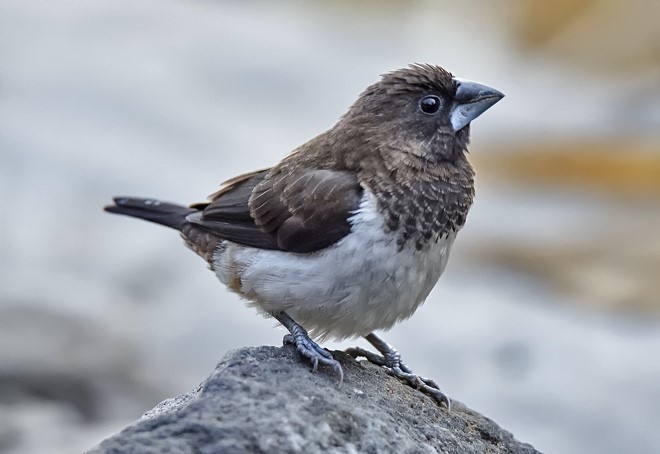
White-rumped Munia, L. s. striata, immature. (Gotheghar, Alibag Taluka, Raigad District, Maharashtra, India; March 26, 2017.) © Tushar Bhagwat
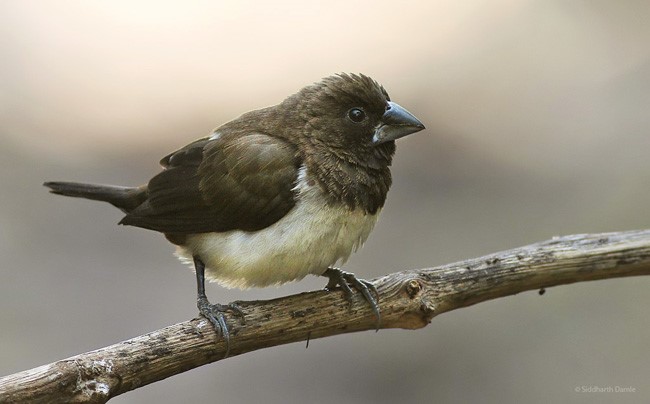
White-rumped Munia, L. s. striata, apparently an immature (dark bill) molting into adult plumage. (Sinhagad, Pune District, Maharashtra, India; December 25, 2015.) © Siddharth Damle
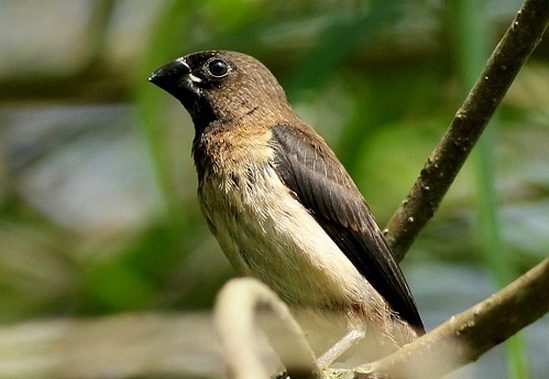
White-rumped Munia, L. s. striata, immature. (Barasat, West Bengal, India; August 23, 2014.) © Subrato Sanyal
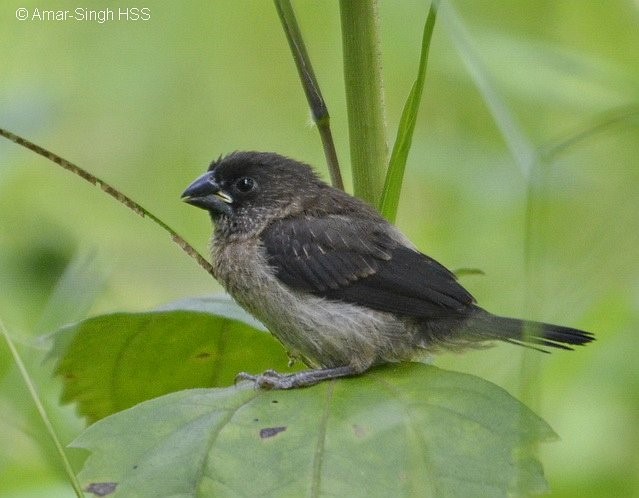
White-rumped Munia, L. s. subsquamicollis, immature—apparently a freshly-fledged juvenile. (Kledang-Sayong Forest Reserve, Ipoh, Perak, Malaysia; October 22, 2011.) © Amar-Singh HSS
Cf. Javan Munia. White-rumped and Javan Munias occur together on the southern Malay Peninsula, Sumatra, and adjacent islands. Javan Munia very closely resembles three subspecies of White-rumped (striata, fumigata, and semistriata) that occur in India, Sri Lanka, and the Andaman and Nicobar Islands, and can also be confused with the local subspecies, subsquamicollis.
The most reliable distinction is the lower back, which is white on White-rumped, but dark-brown on Javan. (Despite its name, White-rumped actually has a dark rump—the white patch is above the rump.) This feature is conspicuous in flight, but otherwise difficult to see.
Notes
Polytypic species consisting of six recognized subspecies.
References
BirdLife International. 2016. Lonchura striata. The IUCN Red List of Threatened Species 2016: e.T22719806A94645276. https://dx.doi.org/10.2305/IUCN.UK.2016-3.RLTS.T22719806A94645276.en. (Accessed April 8, 2020.)
Brazil, M. 2009. Birds of East Asia. Princeton University Press, Princeton, N.J.
Clement, P., A. Harris, and J. Davis. 1993. Finches and Sparrows: An Identification Guide. Princeton University Press, Princeton, N.J.
eBird. 2020. eBird: An online database of bird distribution and abundance. Cornell Lab of Ornithology, Ithaca, N.Y. http://www.ebird.org. (Accessed April 8, 2020.)
Payne, R. 2020. White-rumped Munia (Lonchura striata). In: del Hoyo, J., Elliott, A., Sargatal, J., Christie, D.A. & de Juana, E. (eds.). Handbook of the Birds of the World Alive. Lynx Edicions, Barcelona. https://www.hbw.com/node/61190. (Accessed April 8, 2020.)
Restall, R. 1997. Munias and Mannakins. Yale University Press, New Haven.
Xeno-Canto. 2020. White-rumped Munia – Lonchura striata. https://www.xeno-canto.org/species/Lonchura-striata. (Accessed April 8, 2020.)
